| Copa do Mundo da FIFA Brasil 2014[nb 1] | |
|---|---|

2014 FIFA World Cup logo
| |
| Tournament details | |
| Host country | Brazil |
| Dates | 12 June – 13 July |
| Teams | 32 (from 5 confederations) |
| Venue(s) | 12 (in 12 host cities) |
← 2010
2018 →
| |
The 2014 FIFA World Cup will be the 20th FIFA World Cup, an international men's football tournament that is scheduled to take place in Brazil from 12 June to 13 July 2014.[1] It will be the second time that Brazil has hosted the competition, the previous being in1950. Brazil was elected unchallenged as host nation in 2007 after the international football federation, FIFA, decreed that the tournament would be staged in South America for the first time since 1978 in Argentina, and the fifth time overall.
The national teams of 31 countries advanced through qualification competitions that began in June 2011 to participate with the host nation Brazil in the final tournament. A total of 64 matches are to be played in twelve cities across Brazil in either new or redeveloped stadiums, with the tournament beginning with a group stage. For the first time at a World Cup Finals, the matches will use goal-line technology.[2]
With the host country, all world champion teams since the first World Cup in 1930 (Uruguay, Italy, Germany, England, Argentina,France and Spain) have qualified for this competition. Spain is the defending champion, having defeated the Netherlands 1–0 in the2010 World Cup final to win its first World title. The previous four World Cups staged in South America were all won by South American teams.[3]
Host selection
Main article: 2014 FIFA World Cup bids
On 7 March 2003, FIFA announced that the tournament would be held in South America for the first time since 1978, in line with its then-active policy of rotating the right to host the World Cup among different confederations.[4][5] The decision meant that it would be the first time that two consecutive World Cups will be staged outside Europe.
On 3 June 2003, the South American Football Confederation CONMEBOL initially announced that Argentina, Brazil, and Colombia wanted to host the finals.[6] but, by March 2004, the CONMEBOL associations had unanimously voted to adopt Brazil as their sole candidate.[7]
During the intervening months, Colombia decided that it would enter its own bid,[8] and formally declared its candidacy in December 2006.[9] A week earlier Brazil had also formally announced its interest.[10]
However, Colombia officially withdrew its bid in April 2007, leaving Brazil as the only host candidate.[11] On 30 October 2007 FIFA officially confirmed that Brazil would host the event.[12]
Qualification
Main article: 2014 FIFA World Cup qualification
The allocation of places for the final tournament was decided on 3 March 2011, with the distribution of the 31 places determined through the qualification process unchanged from that of the previous tournament.[13] The qualification draw for the 2014 World Cup was held at the Marina da Glória in Rio de Janeiro on 30 July 2011.[14][15] As the host nation,Brazil automatically qualified for the tournament.
203 of the 208 FIFA national teams at the time participated in the qualification stages, which began on 15 June 2011 and concluded on 20 November 2013. 24 of the 32 eventual qualifiers were present at the previous tournament, with the only debutant being Bosnia and Herzegovina, which qualified for the first time as an independent nation.[16] The highest-ranked absentee according to FIFA World Rankings will be Ukraine,[17] while the OFC region will have no representation at a World Cup Finals for the first time since2002.
Qualified teams
The following 32 teams, shown with October 2013 rankings used for seeding in the draw,[18] qualified for the final tournament.
|
|
|
Prize money
Each participating team will receive at least US$8 million. The World Champions will receive $35 million, while the runners-up will receive $25 million. Teams that lose in the round of 16 will receive $9 million, and the quarter-finalists receive $14 million. The clubs in which the players are playing for at the time of their World Cup departure will receive $70 million as a compensation for insurance costs and expenses, which will be distributed through their national associations. Overall, FIFA will allocate $576 million, a new record, and an increase from the $420 million allocated in South Africa.[19]
Venues
Eighteen locations were presented as potential World Cup host cities: Belém, Belo Horizonte, Brasília, Campo Grande, Cuiabá, Curitiba,Florianópolis, Fortaleza, Goiânia, Maceió, Manaus, Natal, Porto Alegre, Recife, Rio Branco, Rio de Janeiro, Salvador and São Paulo.[20]
FIFA proposes that no more than one city may use two stadiums, and the number of host cities is limited between eight and ten. The proposal of Ricardo Teixeira, the then-Head of the Brazilian Football Confederation, to use twelve host cities in "the interest of the whole country" was however accepted by FIFA in December 2008.[21]
The twelve host cities were announced on 31 May 2009, with Belém, Campo Grande, Florianópolis, Goiânia and Rio Branco being rejected;[22] Maceió had already withdrawn in January 2009. The twelve selections – each the capital of its state – cover all the mainregions of Brazil and create more evenly distributed hosting than the 1950 finals in Brazil provided, when matches were concentrated in the south-east and south.[23] As a result the tournament will require significant long-distance travel for teams.[24]
A reported US$3.47 billion has been spent on stadium projects.[25] Five of the chosen host cities have brand new venues built specifically for the World Cup, while the Estádio Nacional Mané Garrincha in the capital Brasilia was demolished and rebuilt, and the remaining six are being extensively renovated.[26] TheEstádio do Maracanã in Rio de Janeiro, which already holds the record attendance for a FIFA World Cup Finals match (199,854), is the largest of the stadiums and will stage the final. The CBF originally intended to host the opening match at São Paulo's Estádio do Morumbi but it was dropped in 2010 and replaced by the Arena Corinthians after failing to provide financial guarantees for the required improvements.[27]
The first new stadium, the Castelão, in Fortaleza, became operational in January 2013.[28] According to Joe Leahy of the Financial Times, the works in the Castelão, "could set a precedent for other sporting public works", since the project "came in within budget and cheaper per seat" than the Maracanã stadium in Rio.[29][30] Six of the venues were used during the 2013 Confederations Cup.[31] Six further stadiums are however forecast to miss FIFA's original 31 December 2013 deadline for completed works.[32] The completion of the new Arena Corinthians has been hindered by a fatal crane collapse in November 2013 that destroyed part of the stadium and killed two construction workers.[33]
On 22 January 2014, FIFA general secretary Jerome Valcke visited the Arena da Baixada site in Curitiba and stated that the city may be dropped as a World Cup host city if sufficient progress in the renovation of the arena was not shown by 18 February.[34] On 18 February, FIFA confirmed that Curitiba would remain as a World Cup host, despite delays in construction of the stadium.[35]
On 9 March 2014, the Arena da Amazônia, in Manaus, became the ninth World Cup stadium to host a football match, with Remo and Nacional coming to a 2-2 draw.[36] Arena das Dunas, in Natal, and Estádio Beira-Rio, in Porto Alegre also hosted soccer matches already, and are ready for the World Cup.[37][38]
| Rio de Janeiro, RJ | Brasília, DF | São Paulo, SP | Fortaleza, CE |
|---|---|---|---|
| Estádio do Maracanã | Estádio Nacional Mané Garrincha[39] | Arena Corinthians | Estádio Castelão |
| Capacity: 76,935[40]
(renovated)
| Capacity: 70,042[41]
(new stadium)
| Capacity: 68,000 (new stadium) Construction progress: 94%[42] | Capacity: 64,846[43]
(renovated)
|
 | 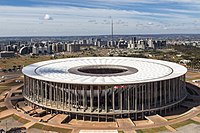 |  | 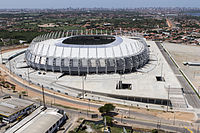 |
| Belo Horizonte, MG | Porto Alegre, RS | ||
| Estádio Mineirão | Estádio Beira-Rio | ||
| Capacity: 62,547
(renovated)
| Capacity: 51,300[44] (renovated)[45] | ||
 |  | ||
| Salvador, BA | Recife, PE | ||
| Arena Fonte Nova | Arena Pernambuco | ||
| Capacity: 56,000[46]
(new stadium)
| Capacity: 46,154
(new stadium)
| ||
 | 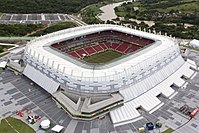 | ||
| Cuiabá, MT | Manaus, AM | Natal, RN | Curitiba, PR |
| Arena Pantanal | Arena da Amazônia | Arena das Dunas | Arena da Baixada |
| Capacity: 42,968 (new stadium) | Capacity: 42,374 (new stadium) | Capacity: 42,086 (new stadium) | Capacity: 43,981[47] (renovated) Construction progress: 85.5%[42] |
 |  | 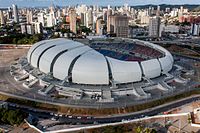 |  |
Final draw
See also: 2014 FIFA World Cup seeding
The 32 participating teams were to be drawn into the eight groups of the group stage. In preparation for this, the teams were organised into four pots with the seven highest-ranked teams joining host nation Brazil in the seeded pot.[48] As with the previous tournaments, FIFA aimed to create groups which maximised geographic separation and therefore the unseeded teams were arranged into pots based on geographic considerations.[49][50]
| Pot 1 (seeds) | Pot 2 (Africa & South America) | Pot 3 (Asia & North America) | Pot 4 (Europe) |
|---|---|---|---|
The final draw for the 2014 World Cup was held at the Costa do Sauípe Resort, Mata de São João in Bahia on 6 December 2013.[51] The ceremony was presented by FIFA Secretary General Jérôme Valcke and Brazilian hostess Fernanda Lima with the balls being drawn by former players representing the eight past World Cup-winning nations: Cafu,Fabio Cannavaro, Alcides Ghiggia, Fernando Hierro, Geoff Hurst, Mario Kempes, Lothar Matthäus and Zinedine Zidane.[52] During the draw additional draw procedures were applied due to the uneven number of teams within the four geographic pots, which moved one randomly drawn European team from Pot 4 into Pot 2.[53][54] No teams from the same confederation were permitted to be grouped together with the exception of UEFA members, where a maximum of two could be.[49][55]
Refereeing
In March 2013, FIFA published a list of 52 prospective referees, each paired with two assistant referees, from all six football confederations for the tournament.[56] On 14 January 2014, the FIFA Referees Committee appointed 25 referee trios and eight support duos representing 43 different countries for the tournament.[57][58]
| Confederation | Referee | Assistants |
|---|---|---|
| AFC | Ravshan Irmatov (Uzbekistan) | Abdukhamidullo Rasulov (Uzbekistan) Bahadyr Kochkarov (Kyrgyzstan) |
| Yuichi Nishimura (Japan) | Toru Sagara (Japan) Toshiyuki Nagi (Japan) | |
| Nawaf Shukralla (Bahrain) | Yaser Tulefat (Bahrain) Ebrahim Saleh (Bahrain) | |
| Ben Williams (Australia) | Matthew Cream (Australia) Hakan Anaz (Australia) | |
| CAF | Noumandiez Doué (Ivory Coast) | Songuifolo Yeo (Ivory Coast) Jean-Claude Birumushahu (Burundi) |
| Bakary Gassama (Gambia) | Evarist Menkouande (Cameroon) Félicien Kabanda (Rwanda) | |
| Djamel Haimoudi (Algeria) | Abdelhalk Etchiali (Algeria) Redouane Achik (Morocco) | |
| CONCACAF | Joel Aguilar (El Salvador) | William Torres (El Salvador) Juan Zumba (El Salvador) |
| Mark Geiger (United States) | Mark Hurd (United States) Joe Fletcher (Canada) | |
| Marco Rodríguez (Mexico) | Marvin Torrentera (Mexico) Marcos Quintero (Mexico) | |
| CONMEBOL | Néstor Pitana (Argentina) | Hernán Maidana (Argentina) Juan Pablo Belatti (Argentina) |
| Sandro Ricci (Brazil) | Emerson De Carvalho (Brazil) Marcelo Van Gasse (Brazil) | |
| Enrique Osses (Chile) | Carlos Astroza (Chile) Sergio Román (Chile) | |
| Wilmar Roldán (Colombia) | Humberto Clavijo (Colombia) Eduardo Díaz (Colombia) | |
| Carlos Vera (Ecuador) | Christian Lescano (Ecuador) Byron Romero (Ecuador) | |
| OFC | Peter O'Leary (New Zealand) | Jan-Hendrik Hintz (New Zealand) Ravinesh Kumar (Fiji) |
| UEFA | Felix Brych (Germany) | Stefan Lupp (Germany) Mark Borsch (Germany) |
| Cüneyt Çakır (Turkey) | Bahattin Duran (Turkey) Tarık Ongun (Turkey) | |
| Jonas Eriksson (Sweden) | Mathias Clasenius (Sweden) Daniel Wärnmark (Sweden) | |
| Björn Kuipers (Netherlands) | Sander van Roekel (Netherlands) Erwin Zeinstra (Netherlands) | |
| Milorad Mažić (Serbia) | Milovan Ristić (Serbia) Dalibor Djurdjević (Serbia) | |
| Pedro Proença (Portugal) | Bertino Miranda (Portugal) Tiago Trigo (Portugal) | |
| Nicola Rizzoli (Italy) | Renato Faverani (Italy) Andrea Stefani (Italy) | |
| Carlos Velasco Carballo (Spain) | Roberto Alonso Fernández (Spain) Juan Carlos Yuste Jiménez (Spain) | |
| Howard Webb (England) | Mike Mullarkey (England) Darren Cann (England) |
| Confederation | Support referee(s) | Support assistant(s) |
|---|---|---|
| AFC | Alireza Faghani (Iran) | Hassan Kamranifar (Iran) |
| CAF | Néant Alioum (Cameroon) | Djibril Camara (Senegal) |
| Daniel Bennett (South Africa) | Aden Marwa (Kenya) | |
| CONCACAF | Roberto Moreno (Panama) | Eric Boria (United States) |
| Walter López (Guatemala) | Leonel Leal (Costa Rica) | |
| CONMEBOL | Víctor Hugo Carrillo (Peru) | Rodney Aquino (Paraguay) |
| OFC | Norbert Hauata (Tahiti) | Mark Rule (New Zealand) |
| UEFA | Svein Oddvar Moen (Norway) | Kim Haglund (Norway) |
Squads
Main article: 2014 FIFA World Cup squads
As with the 2010 tournament, each team's squad for the 2014 FIFA World Cup will consist of 23 players (three of whom must be goalkeepers). Each participating national association has to confirm their final 23-player squad no later than 10 days before the start of the tournament.
Teams are permitted to make late replacements in the event of serious injury, at any time up to 24 hours before their first game.[59]





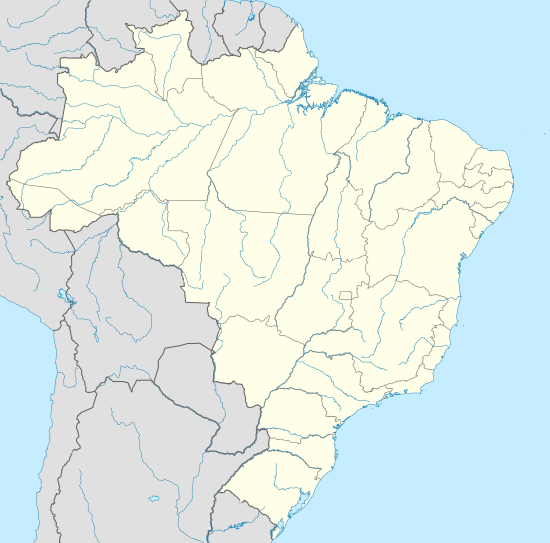




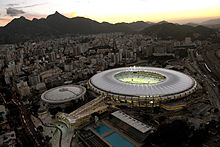


Nenhum comentário:
Postar um comentário